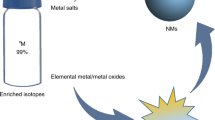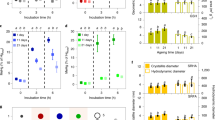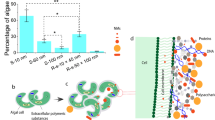Abstract
Nanoparticles in the environment can form by natural processes or be released due to human activities1. Owing to limited analytical methods, the behaviour of nanoparticles in the natural environment is poorly understood and until now they have only been described by the variations in the nanoparticle size or the concentration of the element of interest. Here we show that by using inductively coupled plasma mass spectrometry to measure silver (Ag) isotope ratios it is possible to understand the transformation processes of silver nanoparticles (AgNPs) in the environment. We found that the formation and dissolution of AgNPs under natural conditions caused significant variations in the ratio of natural Ag isotopes (107Ag and 109Ag) with an isotopic enrichment factor (ε) up to 0.86‰. Furthermore, we show that engineered AgNPs have distinctly different isotope fractionation effects to their naturally formed counterparts. Further studies will be needed to understand whether isotope analysis can be used to reveal the sources of AgNPs in the environment.
This is a preview of subscription content, access via your institution
Access options
Subscribe to this journal
Receive 12 print issues and online access
$259.00 per year
only $21.58 per issue
Buy this article
- Purchase on Springer Link
- Instant access to full article PDF
Prices may be subject to local taxes which are calculated during checkout





Similar content being viewed by others
References
Fabrega, J., Luoma, S. N., Tyler, C. R., Galloway, T. S. & Lead, J. R. Silver nanoparticles: behaviour and effects in the aquatic environment. Environ. Int. 37, 517–531 (2011).
Nowack, B., Krug, H. F. & Height, M. 120 years of nanosilver history: implications for policy makers. Environ. Sci. Technol. 45, 1177–1183 (2011).
Mueller, N. C. & Nowack, B. Exposure modeling of engineered nanoparticles in the environment. Environ. Sci. Technol. 42, 4447–4453 (2008).
Gottschalk, F., Sonderer, T., Scholz, R. W. & Nowack, B. Modeled environmental concentrations of engineered nanomaterials (TiO2, ZnO, Ag, CNT, fullerenes) for different regions. Environ. Sci. Technol. 43, 9216–9222 (2009).
Purcell, T. W. & Peters, J. J. Sources of silver in the environment. Environ. Toxicol. Chem. 17, 539–546 (1998).
Luoma, S. N. Silver Nanotechnologies and the Environment: Old Problems or New Challenges? (Woodrow Wilson International Center for Scholars, 2008).
Akaighe, N. et al. Humic acid-induced silver nanoparticle formation under environmentally relevant conditions. Environ. Sci. Technol. 45, 3895–3901 (2011).
Adegboyega, N. F. et al. Interactions of aqueous Ag+ with fulvic acids: mechanisms of silver nanoparticle formation and investigation of stability. Environ. Sci. Technol. 47, 757–764 (2013).
Yin, Y. G., Liu, J. F. & Jiang, G. B. Sunlight-induced reduction of ionic Ag and Au to metallic nanoparticles by dissolved organic matter. ACS Nano 6, 7910–7919 (2012).
Pradhan, A., Seena, S., Pascoal, C. & Cassio, F. Can metal nanoparticles be a threat to microbial decomposers of plant litter in streams? Microb. Ecol. 62, 58–68 (2011).
Choi, O. K. & Hu, Z. Q. Nitrification inhibition by silver nanoparticles. Water Sci. Technol. 59, 1699–1702 (2009).
Hauri, E. H., Carlson, R. W. & Bauer, J. The timing of core formation and volatile depletion in solar system objects from high-precision 107Pd-107Ag isotope systematics. Lunar Planet. Sci. Abs. 31, 1812 (2000).
Schonbachler, M., Carlson, R. W., Horan, M. F., Mock, T. D. & Hauri, E. H. Silver isotope variations in chondrites: volatile depletion and the initial 107Pd abundance of the solar system. Geochim. Cosmochim. Acta 72, 5330–5341 (2008).
Desaulty, A. M. & Albarede, F. Copper, lead, and silver isotopes solve a major economic conundrum of Tudor and early Stuart Europe. Geology 41, 135–138 (2013).
Desaulty, A. M., Telouk, P., Albalat, E. & Albarede, F. Isotopic Ag-Cu-Pb record of silver circulation through 16th-18th century Spain. Proc. Natl Acad. Sci. USA 108, 9002–9007 (2011).
Luo, Y., Dabek-Zlotorzynska, E., Celo, V., Muir, D. C. G. & Yang, L. Accurate and precise determination of silver isotope fractionation in environmental samples by multicollector-ICPMS. Anal. Chem. 82, 3922–3928 (2010).
Chugaev, A. V. & Chernyshev, I. V. High-precision measurement of 107Ag/109Ag in native silver and gold by multicollector inductively coupled plasma mass spectrometry (MC-ICP-MS). Geochem. Int. 50, 899–910 (2012).
Jones, A. M., Garg, S., He, D., Pham, A. N. & Waite, T. D. Superoxide-mediated formation and charging of silver nanoparticles. Environ. Sci. Technol. 45, 1428–1434 (2011).
Wiederhold, J. G. Metal stable isotope signatures as tracers in environmental geochemistry. Environ. Sci. Technol. 49, 2606–2624 (2015).
Yamaguchi, T., Lindqvist, O., Boyce, J. B. & Claeson, T. Determination of the hydration structure of silver ions in aqueous silver perchlorate and nitrate solutions from EXAFS using synchrotron radiation. Acta Chem. Scand. A 38, 423–428 (1984).
Liu, J. Y. & Hurt, R. H. Ion release kinetics and particle persistence in aqueous nano-silver colloids. Environ. Sci. Technol. 44, 2169–2175 (2010).
Horikoshi, S., Hidaka, H. & Serpone, N. Photocatalyzed degradation of polymers in aqueous semiconductor suspensions: V. Photomineralization of lactam ring-pendant polyvinylpyrrolidone at titania/water interfaces. J. Photochem. Photobiol. A Chem. 138, 69–77 (2001).
Yang, L., Dabek-Zlotorzynska, E. & Celo, V. High precision determination of silver isotope ratios in commercial products by MC-ICP-MS. J. Anal. Atom. Spectrom. 24, 1564–1569 (2009).
Luo, Y., Celo, V., Dabek-Zlotorzynska, E. & Yang, L. Effects of precipitation and UV photolysis on Ag isotope ratio: experimental studies. J. Anal. Atom. Spectrom. 27, 299–304 (2012).
Gorham, J. M., Maccuspie, R. I., Klein, K. L., Fairbrother, D. H. & Holbrook, R. D. UV-induced photochemical transformations of citrate-capped silver nanoparticle suspensions. J. Nanopart. Res. 14, 1139 (2012).
Grillet, N. et al. Photo-oxidation of individual silver nanoparticles: a real-time tracking of optical and morphological changes. J. Phys. Chem. C 117, 2274–2282 (2013).
Croteau, M. N., Dybowska, A. D., Luoma, S. N., Misra, S. K. & Valsami-Jones, E. Isotopically modified silver nanoparticles to assess nanosilver bioavailability and toxicity at environmentally relevant exposures. Environ. Chem. 11, 247–256 (2014).
Laycock, A. et al. Synthesis and characterization of isotopically labeled silver nanoparticles for tracing studies. Environ. Sci. Nano 1, 271–283 (2014).
Acknowledgements
The authors acknowledge financial support from the Chinese Academy of Sciences (No. XDB14010400), the National Basic Research Program of China (2015CB931903, 2015CB932003) and the National Natural Science Foundation of China (No. 21377141, 21422509, 91543104). Q.L. acknowledges the support from the Youth Innovation Promotion Association of CAS.
Author information
Authors and Affiliations
Contributions
Q.L. and G.J. conceived and designed the experiments; D.L. and T.Z. performed the experiments; Q.L. and D.L. analyzed the data; Y.C. and Y.Y. gave comments on the paper; Q.L. and G.J. wrote the paper.
Corresponding authors
Ethics declarations
Competing interests
The authors declare no competing financial interests.
Supplementary information
Supplementary information
Supplementary information (PDF 1647 kb)
Rights and permissions
About this article
Cite this article
Lu, D., Liu, Q., Zhang, T. et al. Stable silver isotope fractionation in the natural transformation process of silver nanoparticles. Nature Nanotech 11, 682–686 (2016). https://doi.org/10.1038/nnano.2016.93
Received:
Accepted:
Published:
Issue Date:
DOI: https://doi.org/10.1038/nnano.2016.93
This article is cited by
-
Constraints on ore-forming fluid evolution and guidance for ore exploration in the Zhaxikang Sb–Pb–Zn–Ag deposit in southern Tibet: insights from silver isotope fractionation of galena
Mineralium Deposita (2022)
-
A Preliminary Study on Silver Isotopic Composition in Polymetallic Ore Deposits in Eastern China
Journal of Earth Science (2022)
-
Chemical multi-fingerprinting of exogenous ultrafine particles in human serum and pleural effusion
Nature Communications (2020)
-
Stable isotope labeling of metal/metal oxide nanomaterials for environmental and biological tracing
Nature Protocols (2019)
-
Distinguishing the sources of silica nanoparticles by dual isotopic fingerprinting and machine learning
Nature Communications (2019)



